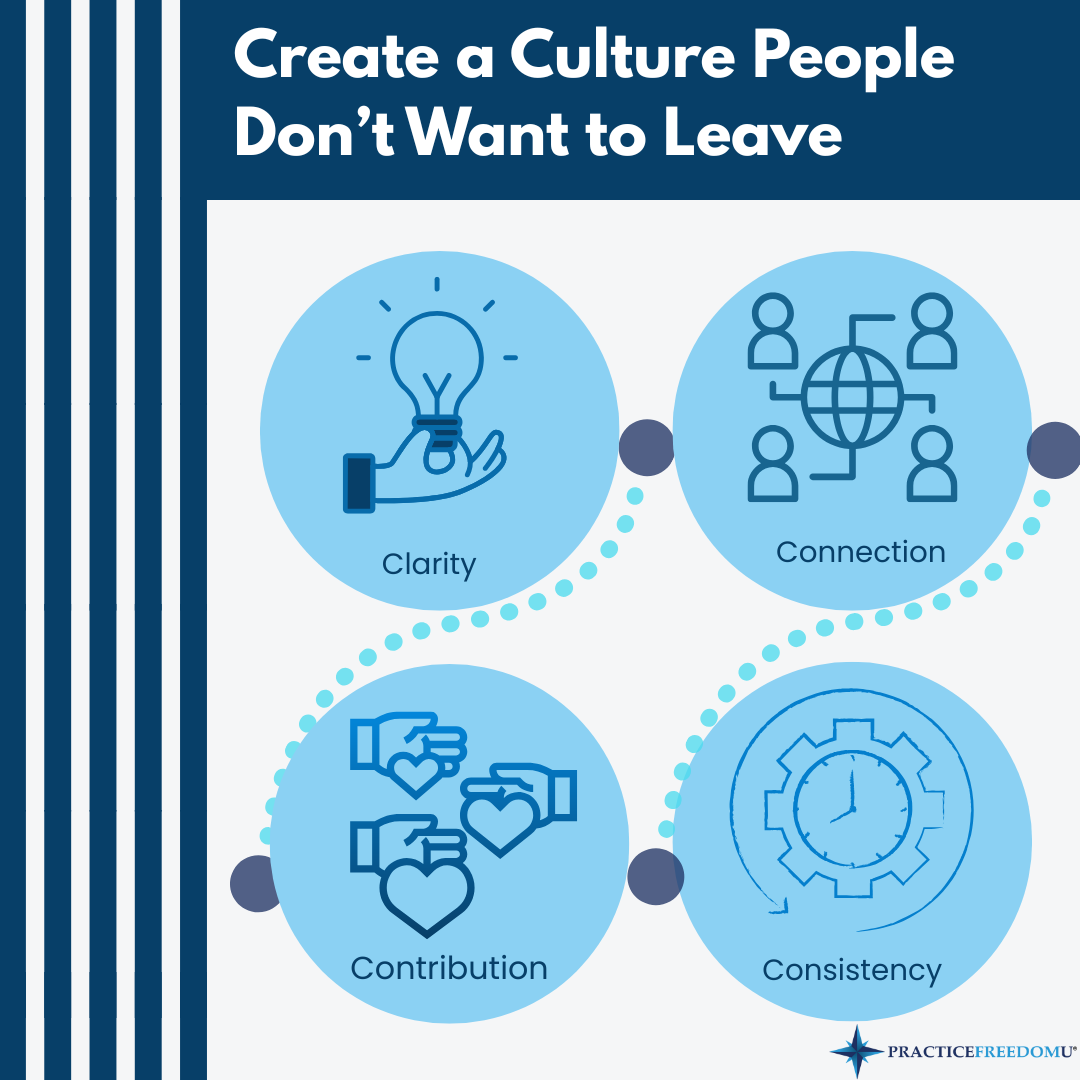Imagine, you finally land that amazing therapist you’ve been searching for. They’re smart, experienced, personable, and they seem to be the perfect fit for your practice. You breathe a sigh of relief, thinking the hard part is over.
But then something happens.
A few months in, the honeymoon period fades. You start noticing missed opportunities, communication breakdowns, and maybe even a drop in morale. Before you know it, your superstar is looking for the exit.
Here’s the hard truth: hiring great talent is only half the battle. The other half—arguably the more important half—is knowing how to keep them, lead them, and help them grow inside your practice.
And if you don’t? You’ll keep hiring… and rehiring… and rehiring.
So, let’s break this down and look at why retention, leadership, and team development are the real keys to long-term success in your private practice.
The Cost of High Turnover in Private Practice
Turnover isn’t just inconvenient—it’s expensive.
The cost of losing a clinician goes beyond salary. You lose patient relationships, continuity of care, and momentum. Your staff morale takes a hit. And worst of all, your culture starts to crack.
Here’s what turnover really costs you:
- Recruiting and onboarding expenses
- Time spent interviewing and training
- Lost revenue from decreased productivity
- Damage to your brand reputation
- Disruption in team dynamics
If you’re constantly replacing people, it’s a sign that something deeper is broken. And it usually comes down to leadership.
People Don’t Leave Jobs, They Leave Leaders
I say this all the time when I speak at conferences and coach practice owners:
“It’s not just about having a great clinician. It’s about being the kind of leader they want to follow.”
Most therapists don’t leave because of pay. They leave because they feel underappreciated, unsupported, or uninspired.
You can hire the best therapist in the country, but if they walk into a culture where they don’t feel heard, challenged, or valued, they’ll start scrolling job boards faster than you can say “manual therapy.”
Ask yourself:
- Are you spending as much time developing your team as you do your marketing plan?
- Do your people have clarity on their roles, expectations, and growth paths?
- Have you created a culture of trust and open communication?
If the answer is “no” or “not really,” that’s your growth edge.
The Myth of the Self-Motivated Team
Too many owners are looking for “rock stars” who will hit the ground running, stay motivated, and “just get it.”
I hate to break it to you, but that’s a fantasy.
Even the most talented team members need:
- Clear expectations
- Regular feedback
- Opportunities to grow
- A mission to believe in
When you provide those things consistently, you create an environment where great people want to stay.
And the beautiful part? That’s what creates scalability.
Leadership Isn’t Just a Skill, It’s a Commitment
Being a practice owner isn’t just about treating patients or managing operations. It’s about leading people. (Harvard Business Review)
That means:
- Investing in leadership development (yours and your team’s)
- Creating systems for communication and accountability
- Learning how to coach, not just manage
You don’t have to be the world’s most charismatic leader. But you do have to be intentional. Because the way you show up directly impacts your team’s engagement, retention, and performance.
And if you’re not leading, someone else—or something else—is.

Create a Culture People Don’t Want to Leave
Culture is not ping-pong tables and pizza Fridays.
Culture is how your team feels when they walk through the door. It’s how problems get solved, how feedback is given, and how people are treated, especially when no one is watching.
If you want to keep top talent, you need to build a culture that prioritizes:
- Clarity – Everyone knows what’s expected and how to succeed
- Connection – There’s trust, respect, and open dialogue
- Contribution – Each person feels like they’re making a difference
- Consistency – Your values show up in how you lead, hire, and manage
I call this the 4 C’s of Culture, and they’re game changers when applied intentionally in private practice. (Entrepreneur)
Growth Is the New Job Security
One of the top reasons great people leave? They stop growing.
Clinicians want to learn. They want to advance. They want to make a bigger impact. If you’re not providing a clear path for that growth, they’ll find it somewhere else. (Forbes)
Here are a few ways to keep your team growing:
- Offer clinical mentorship and CEU support
- Create leadership tracks for future clinic directors
- Develop systems for regular goal-setting and feedback
- Include them in business strategy conversations
When your team grows, your practice grows. Period.
The Leadership Development Gap
Most private practice owners were trained as clinicians, not leaders.
So it’s no surprise that many struggle with things like delegation, difficult conversations, or team motivation. That’s not a flaw, it’s just a gap.
The good news? Leadership can be learned.
I’ve worked with hundreds of practice owners who went from stressed-out managers to confident, inspiring leaders. And they didn’t do it by reading books or watching YouTube videos. They did it by getting coached, building systems, and committing to their growth.
If you want to keep your best people, you need to become the leader they deserve.
Don’t Just Hire for Skill, Hire for Fit
Yes, you want talented clinicians. But you also want team players who align with your values, your mission, and your vision.
That’s why your hiring process should include:
- Behavioral interviews focused on core values
- Cultural fit assessments
- Clear communication of expectations and vision
When you hire people who believe what you believe, retention becomes a lot easier.
Because let’s be honest, skills can be taught. Attitude can’t.
From Transactional to Transformational Leadership
Here’s the shift that will change everything:
Stop thinking of your team as employees who perform tasks.
Start thinking of them as people you’re helping to grow, personally and professionally.
That’s transformational leadership.
And it’s what separates the thriving, culture-driven practices from the ones constantly stuck in the hiring cycle.
Takeaway: The Real Work Begins After the Hire
Hiring is important. You want the best people you can find.
But if that’s where your leadership journey ends, you’re setting yourself up for frustration, turnover, and stalled growth.
The real work starts after the offer letter is signed:
- Building trust
- Creating systems
- Coaching performance
- Inspiring growth
- Leading with vision
This is how you keep great talent. This is how you build a practice that runs on purpose, not panic.
And this is how you create a team that doesn’t just work for you, but with you.
Your dream practice isn’t built on having the right team.
It’s built on becoming the right leader for that team.
And here’s the best part—this is how you create freedom.
When you build a team that’s aligned, committed, and growing with you, you’re no longer stuck in the weeds. You’re not the only one driving the bus. Instead, you’ve created a practice that can thrive without you having to do it all. That’s what real practice freedom looks like, not just having more time, but having more trust in the people around you. And it all starts with leading them well, after the hire.
So, the next time you’re tempted to pour all your energy into finding that next “perfect hire,” take a moment to ask yourself:
“What am I doing to keep, grow, and lead the great people I already have?”
Because that’s where the real battle—and the real opportunity—begins.
————————————————————-
Are you ready for a coach? Join the hundreds of physical therapy owners who are building the practice of their dreams with the support, guidance and direction of a Practice Freedom U Coach. Take the first step towards creating a business that sets you free by scheduling a Discovery Call



